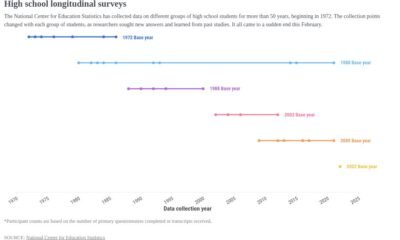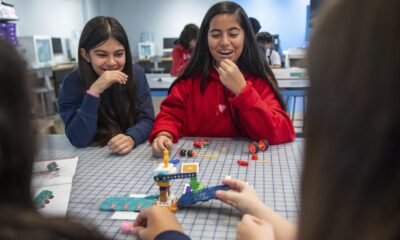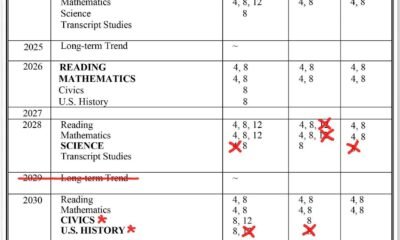Education
How no-strings cash changed the lives of teens
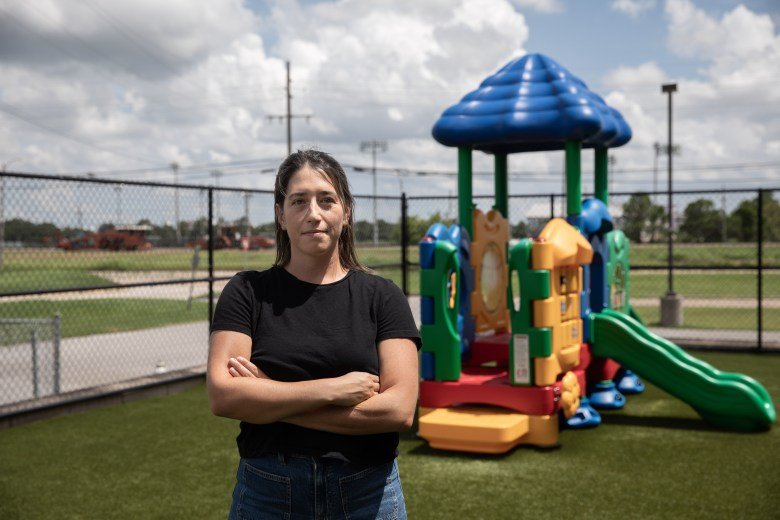
NEW ORLEANS — Kapri Clark used the $50 to help pay for her braces. Lyrik Grant saved half of it, and used the rest for dance classes. Kevin Jackson said he squandered the cash, on wings, ride shares for dates and some DJ equipment he later tossed.
For the past five years, Clark, Grant, Jackson and hundreds of high schoolers in New Orleans have shopped — or saved — as part of a project to explore what happens if you give cash directly to young people, no strings attached.
“That was the most helpful thing ever,” said Clark, now a student at the University of Louisiana at Lafayette, who said she could still use that extra cash.
“The $50 study,” as it’s known, began at Rooted School, a local charter school, as an experiment to increase attendance. The study has since grown to eight other high schools in the city, as well as Rooted’s sister campus in Indianapolis, with students randomly selected to receive $50 every week for 40 weeks, or $2,000 total. By comparing their spending and savings habits to a larger control group, researchers wanted to figure out whether the money improved a teen’s financial capability and perception of themselves. They also wanted to know: Could the cash boost their grade-point averages and reading scores?
Now, as the experiment expands to Washington, D.C., and perhaps Texas, a final report of the $50 study suggests a little bit of spending cash can make a difference in young people’s lives.
The report, released Tuesday, shows students who received the cash payments were slightly more likely to attend school than those who didn’t. Academic performance did not differ between the groups. But financially, the extra cash helped students acquire stronger long-term planning skills and familiarity with savings accounts and other financial products. They ended the study, on average, with $300 saved away — a 15 percent savings rate, triple the national average for American adults.
“When young people are given the opportunity to manage money in low-stakes environments, they build the habits that shape long-term financial health,” said Stacia West, an associate professor at the University of Tennessee, Knoxville and co-founder of the Center for Guaranteed Income Research, which partnered with the Rooted School Foundation to run the study. “The short-term habits we’re seeing are laying the foundation for lifelong financial capability.”
Related: A lot goes on in classrooms from kindergarten to high school. Keep up with our free weekly newsletter on K-12 education.
Across the United States and the globe, hundreds of communities have tinkered with some form of universal basic income, or UBI, a social welfare program that provides people with regular cash payments to meet their needs. Direct cash transfer programs like the $50 study or the child tax credit for families are similar, but they often provide smaller amounts and target specific populations to boost a person’s income. Many studies have linked UBI to financial stability and better employment and health outcomes.
In the U.S. and Canada, researchers have found links between cash transfer pilots that focus on low-income families and better test scores and graduation rates for their kids. So far, though, few experiments have targeted young people or examined how the programs influence their lives specifically.
“There’s a deep, deep distrust that we adults have of young people,” said Jonathan Johnson, CEO of the Rooted School Foundation, which operates the network’s four charter schools. “That distrust is to their detriment.”
In New Orleans, roughly 4 in 5 of Rooted students come from economically disadvantaged families, and during the pandemic, many struggled to prioritize school. Some students skipped class to provide child care for their working parents, or because they needed to work themselves, according to Johnson. With some seed funding from a local education nonprofit, Rooted started a “micropilot” to test whether cash could help students make ends meet and get themselves to school.
The original cohort included 20 students, half of whom received the $50 payment. In that micropilot, those receiving the cash saw their material wellbeing improve, meaning their family could more easily afford rent or utilities, and they gained skills around setting financial goals. Rooted added students from its Indianapolis campus and another high school in New Orleans, G.W. Carver. And for their final report released this week, researchers sifted through the spending and survey data from 170 students who received the cash payments and 210 students who did not.
The two-year report found students in the treatment group attended 1.23 more days of school, and spent close to half their funds on essentials like food and groceries. The report also noted that 70 percent of all students at the participating schools qualify for subsidized meals, suggesting “this spending may reflect efforts to meet immediate nutritional needs.” One 12th grader in a survey mentioned using the money to feed their siblings.
Kapri Clark recalled waiting every Wednesday morning for the $50 deposit to appear in her banking app. And every Wednesday afternoon, during her senior year at Carver High School, she put that money toward her $200 bill for braces she covered out of pocket.
She braided hair to cover the rest, and still books clients when she has time in between her studies to become a nurse at the Lafayette campus. Even in college, Clark can see the need for some supplemental income for herself and her peers.
“I make enough to take care of myself, but I watch every dollar,” said Clark. “There’s a lot of people struggling in life to eat, to live. Think if they got kids.”
Read Irvin, chief of staff for Collegiate Academies in New Orleans, a network of five charter high schools that includes Carver High, said the $2,000 had provided the extra incentive a few students needed to stick it out until graduation. “That’s incredibly impactful for their life trajectories,” she said.
Related: How to help young kids: Give their parents cash
In January 2024, the city of New Orleans invested $1 million to bankroll another extension of the study, as part of an economic mobility initiative that tapped federal Covid relief funding. During the pandemic, a skyrocketing murder rate and spike in overall crime had convinced the city to help more residents, especially young people, find stability.
“Research shows that people who are economically stable are less likely to commit crime,” said Courtney Wong, the city’s deputy director of economic development.
The city funding not only expanded the $50 study to nine high schools, it also set a longer timeline for the research: About 800 seniors who participate will have their data tracked for 18 months after their graduation.
A former high school teacher and administrator, Wong said $50 could have made a difference in the lives of many of her former students.
“This targets young people in that perfect moment,” she said. “They’re in the right spot where even a little amount of help could have big, positive impacts before issues of crime or unemployment or things like that even come up.”
Researchers also found students who received the $50 reported greater agency. They felt more control over their finances and more confidence about making long-term financial decisions. Students, according to the report, aligned their spending to future goals such as college prep classes and getting a driver’s license.
Lyrik Grant, a rising junior at Carver High School, is the second-youngest of six kids with two working parents. She could ask them for help, but the $50 allowed Grant to afford the tights and tops she needed for dance class on her own. The money helped cover a college entrance exam, which she aced, and Grant wants to learn how to drive soon.
“My first thought was: What am I going to do with all this money?” Grant said, adding that the cash helped some of her classmates find financial stability. “Children don’t always want to spend their parent’s money, and some parents don’t always have money to give them.”
Still, for some students, the money wasn’t exactly life-changing. Irvin of Collegiate Academies said many used the cash to “just be teenagers.”
That was true for Kevin Jackson, a rising junior at Rooted School New Orleans.
“It’s cool to get free money,” he said. “I was spending it on the TikTok shop: posters, keyboards, lights — stuff I liked, not stuff I actually needed.”
Related: All-charter no more: New Orleans opens its first traditional school in nearly two decades
Despite the studies that show a positive impact from UBI, many Americans appear skeptical of the idea of a federal program that gives unconditional financial support to people. Aditi Vasan, a pediatrician and researcher at PolicyLab at the Children’s Hospital of Philadelphia, said skeptics often worry about recipients using public dollars for drug use or other illicit behavior, even though the data does not support that.
Still, that fear will likely keep any large-scale cash transfer program from being adopted in the United States any time soon, she said.
“That concern exists certainly for cash transfers in general but might be particularly magnified for teens,” Vasan said. “We’ve not seen that play out in the evidence from the quality studies that have been done.”
Next year, in Washington, D.C., the nonprofit Education Forward will fund a pilot of the $50 study with 40 high schoolers. The Rooted school network resumed talks, meanwhile, to take the study to neighboring Texas, after state lawmakers earlier this year failed to pass legislation that threatened to ban local governments from adopting guaranteed income programs.
Talia Livneh, senior director of programs for the Rooted School Foundation, said the politics may need to catch up to the research.
“I don’t think what we’re doing is so radical. I believe this just works,” she said. “Kids don’t lack character. They lack cash,” Livneh added. “They deserve deep, deep trust that students and people know what’s best for them.”
It’s been four years since Vernell Cheneau III received the $50 for 40 weeks while a student at Rooted in New Orleans, and his economic life isn’t easy. He struggled for months to find part-time work in his hometown. But on a recent summer morning, the same day he finally received a job offer, Cheneau recalled what he learned from the study.
“You learn that money goes fast, especially if it’s free,” said Cheneau, 22.
As a student, he tried to use the money to build some credit history. Since then, he’s learned the full cost of being an adult in America: health care, fuel and maintenance for his car, getting your hair done before a new job. Cheneau has also spent that time trying to convince friends and family to support UBI.
Most oppose giving “free” money to people, he said. “How much does it cost to feed children? Get to work? We can’t just allow people to drown.”
“Everything costs something,” Cheneau added. “If you’re stuck in a rut, it’s expensive to restart. In this country, it’s expensive to be poor.”
Contact staff writer Neal Morton at 212-678-8247, on Signal at nealmorton.99, or via email at morton@hechingerreport.org.
This story about cash transfer programs was produced by The Hechinger Report, a nonprofit, independent news organization focused on inequality and innovation in education. Sign up for the Hechinger newsletter.
Education
Universities of Greenwich and Kent to merge

The University of Greenwich and and the University of Kent have announced a merger under the proposed name of London and South East University Group, from 2026.
While both institutions will retain their individual identities, much of the professional services and operational cost base will be merged as one institution. This will include retaining just one vice chancellor.
The universities are keen to stress that new and existing students will not be impacted and will be able to study and graduate with the institution they selected.
The move is being reported as the creation of a new ‘super-university’ that stretches all the way from the University of Kent’s campus in Canterbury to central London. Currently both universities share facilities at the Medway campus in Gillingham.
The merger will create a combined capacity of more than 47,000 students, making it one of the UK’s largest institutions, and has been welcomed by both the Office for Students and the Department for Education as an “innovative approach”.
Georgina Randsley de Moura, acting vice chancellor and president at the University of Kent commented: “It’s no secret that the sector’s got significant financial challenges and there’s been a lot of discussion in the sector over the last year about how we need to self-solve for that.
When asked about job losses, the acting VC said: “The reality is, and it’s the elephant in the room, that all universities have had to restructure. What this does is it gives us a real opportunity to say, what could a bigger structure look line.”
More than 40% of the British higher education sector is believed to be in financial deficit with continued job losses evident across the sector.
Jacqui Jenkins, director of networks and engagement at The PIE, who recently joined from The British Council, reacted to the news saying “It’s been evident over the last few years that competing wasn’t really helping either institution; it makes total sense for these two universities to collaborate.
“As this report suggests, instead of undercutting each other, [the universities] may pool recruitment strengths to attract both domestic and international students under a regional umbrella. Domestically, these two universities have long competed for the so-called commuter student, and internationally, I suspect this newly formed multi-university group could be one of the world’s biggest financial, tech, legal, and cultural hubs.”
The UK government has yet to announce plans for higher education reform, but has reiterated the intention to impose a 6% levy on international student income.
The first of its kind, the creation of a multi-university group between the universities of Kent and Greenwich could now be viewed as a template to safeguard against financial risk, whilst leveraging the combined strengths of institutions to create ‘super-university’ structure.
The PIE News will continue to follow this story.
Education
Kent and Greenwich universities to merge in attempt to improve financial viability | Higher education

The universities of Kent and Greenwich are set to merge in an attempt to improve their financial viability against a backdrop of economic turmoil across higher education in the UK.
Under the proposed name of London and South East University Group, the single institution will have one vice-chancellor from the academic year starting in autumn 2026. The two universities combined will have 28,000 first degree undergraduates, according to the Higher Education Statistics Agency.
The universities said the combined institution would provide a stronger financial foundation to overcome the economic challenges facing universities now and in the future.
The Office for Students (OfS), England’s higher education regulator,welcomed the move and suggested that more universities may explore similar options as their income has fallen for the third year in a row.
This is due to falls in international students after immigration and visa changes as well as the declining real-terms value of the tuition fee paid by UK students, with the result that 40% of English universities are now believed to be in financial deficit.
The Department for Education (DfE) said ministers “welcome innovative approaches such as this one”.
The vice-chancellors of both universities told the BBC that the move was not a takeover by either institution, although they added that the new university model would be “resilient and financially viable”.
The new university will operate across the existing campuses, including in Medway, where students from both Greenwich and Kent already share the library and other facilities.
Kent has one other campus, in Canterbury, about 48km from Medway, while Greenwich has two other campuses, one on the banks of the River Thames in Greenwich – itself about 45km from Medway – and the other in Avery Hill, south-east London, about 38km away.
Many institutions have been trying to repair budget deficits by slashing building and maintenance spending as well as cutting courses and staff, with the sector expected to sell off more than £400m worth of land and property this year.
Prof Georgina Randsley de Moura will remain the interim leader of Kent until the merger, when Prof Jane Harrington, who runs Greenwich, will become the vice-chancellor of the new institution.
Prof Randsley de Moura said the “trailblazing model” would enable the universities within the new group to retain their name, identity and campuses.
Students will be unaffected by the change, with applications continuing as normal to each institution and degrees awarded in the name of Kent or Greenwich.
Prof Harrington said the universities had worked together on the Medway campus for 20 years and now wanted to contribute more to the economy across London and the south-east.
She added that students would “absolutely categorically” be able to complete any course they are already enrolled on, including those starting university this autumn.
The universities said there are no immediate plans for job losses. Prof Harrington said that costs would be saved by reducing senior roles.
In May, Greenwich confirmed it was cutting the equivalent of 15 full-time posts by August. Kent has already started winding down some courses to reduce costs after posting a deficit for another year in 2024.
Across England, job losses at many institutions over the last couple of years have been mounting, with the University and College Union (UCU) estimating the overall number of posts cut at about 5,000.
Mergers were previously rare but have now become more common, with City St George’s created from two separate University of London universities last year, although most others have involved smaller or specialist institutions.
The OfS chair, Edward Peck, said: “The OfS’s financial sustainability analysis has starkly demonstrated the challenges facing the sector. More universities taking steps to ensure their long-term financial future will likely explore the possibility of working more closely with partners, up to and including mergers. While the OfS will consider any regulatory decisions in this case carefully and on their merits, these initial proposals are to be welcomed.”
A Department for Education spokesperson said: “This collaboration shows how strong partnerships in higher education can help enable delivery of world-class teaching and research while maintaining the best interests of students.
“Through our Plan for Change we are committed to fixing the foundations of higher education, and we will soon publish our plans for HE reform as part of the post-16 education and skills strategy white paper.”
Education
AI in Personalized Learning and Education Technology Market Set
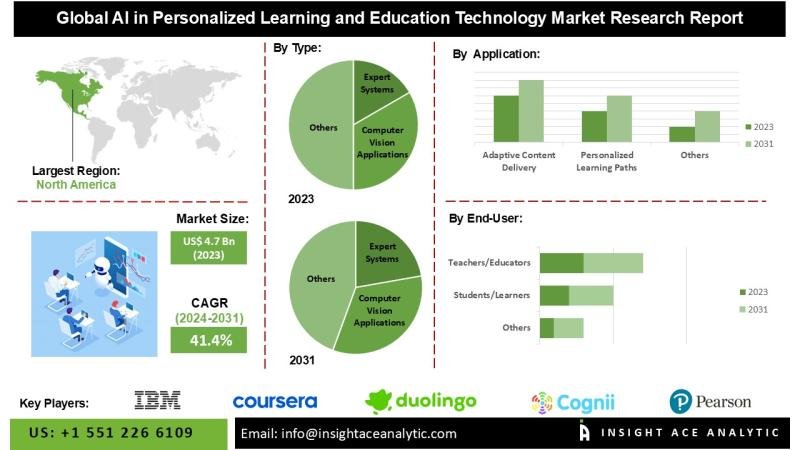
InsightAce Analytic Pvt. Ltd. announces the release of a market assessment report on the “Global AI in Personalized Learning and Education Technology Market – (By Type (Machine Learning Algorithms, Natural Language Processing (NLP) Systems, Expert Systems, Computer Vision Applications, Intelligent Tutoring Systems (ITS), Virtual Learning Environments (VLEs), Adaptive Learning Platforms), By Application (Adaptive Content Delivery, Personalized Learning Paths, Individualized Assessment and Feedback, Intelligent Content Creation, Smart Content Recommendations, Personalized Learning Analytics, Student Progress Monitoring), By Educational Level (K-12 Education, Higher Education (Colleges and Universities), Corporate Training and Professional Development, Language Learning, Skill-based Learning), By End-User (Students/Learners, Teachers/Educators, Administrators/Schools and Institutions, Corporations and Enterprises, Language Learning Institutions)), Trends, Industry Competition Analysis, Revenue and Forecast To 2034.”
According to the latest research by InsightAce Analytic, the Global AI in Personalized Learning and Education Technology Market is valued at USD 6.5 Bn in 2024, and it is expected to reach USD 208.2 Bn by the year 2034, with a CAGR of 41.4% during the forecast period of 2025-2034.
Get Free Access to Demo Report, Excel Pivot and ToC: https://www.insightaceanalytic.com/request-sample/2692
Artificial Intelligence (AI) is increasingly being integrated into personalized learning and educational technology, driving a transformative shift in traditional teaching methodologies. AI-powered personalized learning leverages data-driven algorithms to evaluate various aspects of student performance, learning preferences, and progression, enabling the creation of customized curricula and targeted interventions. This approach allows educators to develop adaptive learning pathways that align with each student’s unique strengths and areas for improvement, fostering a more engaging and effective educational experience.
Effective learner segmentation is critical to the successful deployment of AI in personalized education. By classifying students based on attributes such as learning styles, academic performance, and areas of interest, educators can deliver tailored content and interventions that address specific learning needs. This individualized approach enhances engagement and supports deeper comprehension of complex concepts, thereby contributing to improved learning outcomes.
AI systems can analyze large volumes of data to identify patterns and trends, facilitating the development of precise segmentation strategies. Machine learning models further augment this capability by integrating data from multiple sources-including assessments, quizzes, and peer interactions-providing a holistic understanding of each student’s learning trajectory.
List of Prominent Players in the AI in Personalized Learning and Education Technology Market:
• Coursera
• Duolingo
• Khan Academy
• IBM Watson Education
• Blackboard
• Cognii
• Knewton
• Pearson
• Squirrel Al Learning
• Content Technologies, Inc.
• Third Space Learning
• ALEKS (Assessment and Learning in Knowledge Spaces)
Expert Knowledge, Just a Click Away: https://calendly.com/insightaceanalytic/30min?month=2025-03
Market Dynamics
Drivers:
The rising demand for personalized learning experiences tailored to students’ diverse needs and learning paces is a key driver of the AI in education market. AI-powered platforms, including adaptive learning systems, enable the analysis of student data to deliver customized educational content, thereby enhancing overall learning outcomes. The rapid expansion of remote and hybrid learning models has further accelerated AI adoption by facilitating more interactive and efficient virtual classrooms.
Widespread access to digital devices and reliable internet connectivity supports the seamless integration of AI solutions into educational environments. Additionally, the growing emphasis on data-driven insights to inform instructional strategies and policy-making contributes to market growth, as AI provides actionable analytics and feedback to educators and administrators.
Challenges:
The AI in education market faces several challenges, including concerns around data privacy and security, particularly the protection of sensitive student information. Integrating AI solutions with existing educational infrastructure can be complex, which may impede smooth adoption. High implementation and maintenance costs can limit deployment, especially for institutions with constrained budgets.
Other barriers include the lack of standardized curricula, insufficient educator training, and the digital divide, which results in unequal access to technology. Ethical considerations, such as algorithmic bias and AI-driven decision-making, also require careful management to ensure equitable learning outcomes.
Regional Trends:
North America is expected to lead the global AI in personalized learning market, driven by advanced technological infrastructure, substantial investment in educational technology, and widespread adoption of AI-enabled solutions across K-12 and higher education. Europe is projected to capture a significant market share, supported by progressive educational reforms, increased funding for edtech initiatives, and a strong focus on personalized learning to enhance student performance.
Collaborative efforts between educational institutions and technology providers in Europe are further fostering innovation in AI-based solutions, enabling tailored learning experiences that address diverse student needs and improve engagement.
Unlock Your GTM Strategy: https://www.insightaceanalytic.com/customisation/2692
Recent Developments:
• In May 2024, Khan Academy and Microsoft collaborated to enhance the availability of AI tools that customized instruction and facilitated enjoyable learning experiences. Microsoft provided Khan Academy with free access to the pilot of Khanmigo for Teachers by donating access to Azure AI-optimized infrastructure, allowing all K-12 educators in the U.S. to benefit from this service at no cost. Consequently, Khanmigo for Teachers is currently being operated by Azure OpenAI Service.
• In Jan 2024, Coursera has introduced new artificial intelligence (AI) functionalities to cater to the requirements of learners in India. There are currently more than 4,000 courses offered in the Hindi language. Furthermore, Coursera has revealed its acquisition of new industry and campus clients, as educational institutions throughout India have enthusiastically adopted online learning to provide their employees and students with essential digital competencies.
Segmentation of AI in Personalized Learning and Education Technology Market-
AI in Personalized Learning and Education Technology Market By Type:
• Machine Learning Algorithms
• Natural Language Processing (NLP) Systems
• Expert Systems
• Computer Vision Applications
• Intelligent Tutoring Systems (ITS)
• Virtual Learning Environments (VLEs)
• Adaptive Learning Platforms
AI in Personalized Learning and Education Technology Market By Application:
• Adaptive Content Delivery
• Personalized Learning Paths
• Individualized Assessment and Feedback
• Intelligent Content Creation
• Smart Content Recommendations
• Personalized Learning Analytics
• Student Progress Monitoring
AI in Personalized Learning and Education Technology Market By Educational Level:
• K-12 Education
• Higher Education (Colleges and Universities)
• Corporate Training and Professional Development
• Language Learning
• Skill-based Learning
AI in Personalized Learning and Education Technology Market By End-User:
• Students/Learners
• Teachers/Educators
• Administrators/Schools and Institutions
• Corporations and Enterprises
• Language Learning Institutions
AI in Personalized Learning and Education Technology Market By Region-
North America-
• The US
• Canada
• Mexico
Europe-
• Germany
• The UK
• France
• Italy
• Spain
• Rest of Europe
Asia-Pacific-
• China
• Japan
• India
• South Korea
• South East Asia
• Rest of Asia Pacific
Latin America-
• Brazil
• Argentina
• Rest of Latin America
Middle East & Africa-
• GCC Countries
• South Africa
• Rest of Middle East and Africa
Read Overview Report- https://www.insightaceanalytic.com/report/ai-in-personalized-learning-and-education-technology-market/2692
About Us:
InsightAce Analytic is a market research and consulting firm that enables clients to make strategic decisions. Our qualitative and quantitative market intelligence solutions inform the need for market and competitive intelligence to expand businesses. We help clients gain competitive advantage by identifying untapped markets, exploring new and competing technologies, segmenting potential markets and repositioning products. Our expertise is in providing syndicated and custom market intelligence reports with an in-depth analysis with key market insights in a timely and cost-effective manner.
Contact us:
InsightAce Analytic Pvt. Ltd.
Visit: www.insightaceanalytic.com
Tel : +1 607 400-7072
Asia: +91 79 72967118
info@insightaceanalytic.com
This release was published on openPR.
-

 Business2 weeks ago
Business2 weeks agoThe Guardian view on Trump and the Fed: independence is no substitute for accountability | Editorial
-
Tools & Platforms4 weeks ago
Building Trust in Military AI Starts with Opening the Black Box – War on the Rocks
-

 Ethics & Policy1 month ago
Ethics & Policy1 month agoSDAIA Supports Saudi Arabia’s Leadership in Shaping Global AI Ethics, Policy, and Research – وكالة الأنباء السعودية
-

 Events & Conferences4 months ago
Events & Conferences4 months agoJourney to 1000 models: Scaling Instagram’s recommendation system
-

 Jobs & Careers2 months ago
Jobs & Careers2 months agoMumbai-based Perplexity Alternative Has 60k+ Users Without Funding
-

 Education2 months ago
Education2 months agoVEX Robotics launches AI-powered classroom robotics system
-

 Podcasts & Talks2 months ago
Podcasts & Talks2 months agoHappy 4th of July! 🎆 Made with Veo 3 in Gemini
-

 Education2 months ago
Education2 months agoMacron says UK and France have duty to tackle illegal migration ‘with humanity, solidarity and firmness’ – UK politics live | Politics
-

 Funding & Business2 months ago
Funding & Business2 months agoKayak and Expedia race to build AI travel agents that turn social posts into itineraries
-

 Podcasts & Talks2 months ago
Podcasts & Talks2 months agoOpenAI 🤝 @teamganassi


